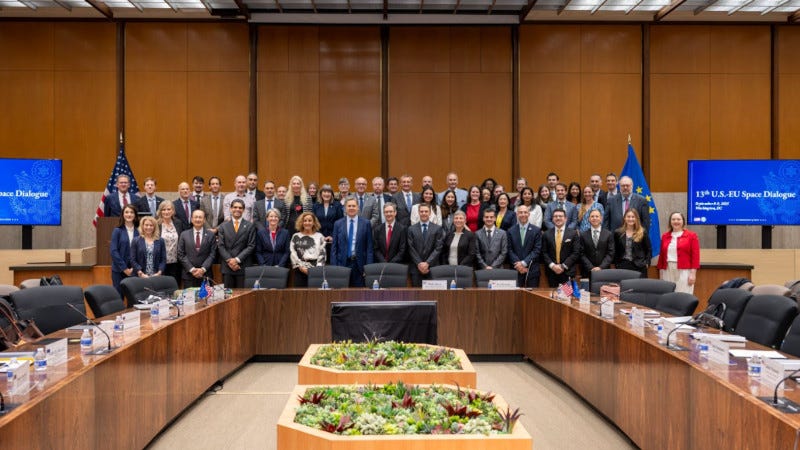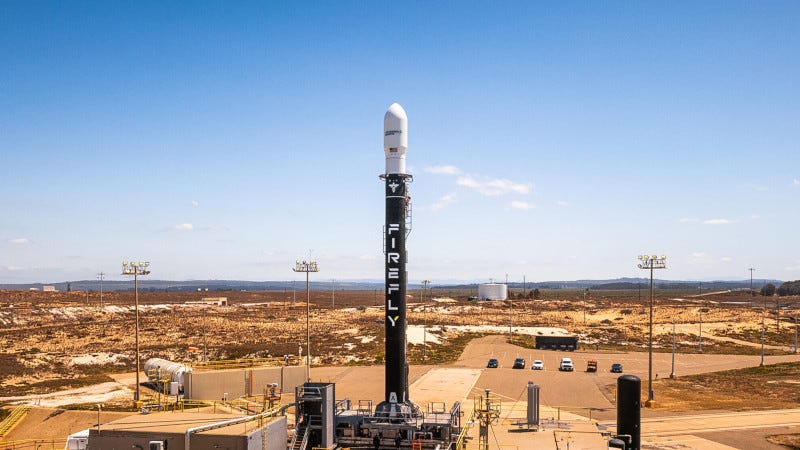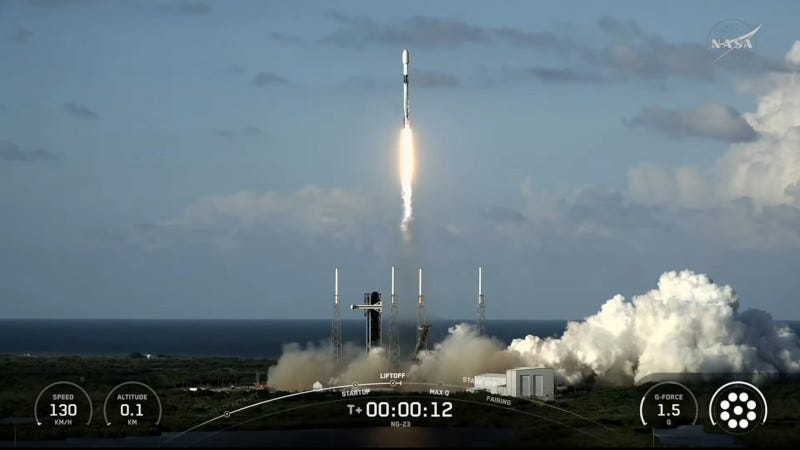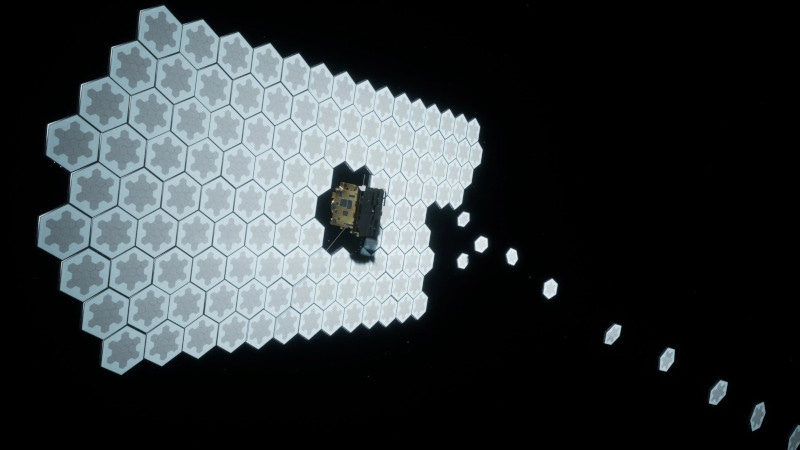Representatives from the U.S. Department of Commerce (DOC) joined U.S. government and European Union (E.U.) colleagues in Washington, D.C. recently for the 13th U.S.-E.U. Space Dialogue.
DOC attendees included representatives from NOAA’s National Environmental Satellite, Data, and Information Service, the Office of Space Commerce, the National Institute of Standards and Technology, and the National Telecommunications and Information Administration. Deputy Assistant Secretary for International and Space Affairs Juan Caro led the DOC delegation’s participation.
Over two days of meetings, the U.S. and E.U. delegations discussed topics ranging from spaceflight safety and space security concerns, to reducing barriers to trade and commerce in the space sector.
During a roundtable involving E.U. government officials and U.S. space industry, association, and academic sector representatives, the U.S. participants were afforded the opportunity to learn more about the European Commission’s draft EU Space Act, and to provide candid perspectives and feedback directly to E.U. leaders about the draft text in an effort to strengthen person-to-person trans-Atlantic space sector relationships.
The 14th iteration of the Space Dialogue will be held in Brussels.
-0-
The FAA has cleared the Firefly Alpha rocket to return to flight following the Flight 6 mishap on April 29.
According to the company website, a thorough investigation was conducted in conjunction with the FAA, while at the same time an Independent Review Board of multiple government agencies, customers, and industry experts was assembled. The findings confirmed Firefly’s flight safety system performed nominally through all phases of flight. Both Alpha stages landed safely in the Pacific Ocean and the launch posed no risk to public safety.
Alpha Flight 6 lifted off and ascended nominally through stage separation. Alpha’s first stage then experienced a rupture milliseconds after stage separation. The pressure wave hit Alpha’s second stage, leading to the loss of the engine’s nozzle extension and substantially reducing stage two thrust. The second stage was able to recover attitude control and continued to ascend to an altitude of 320 km (≈200 miles) until running out of propellant. The vehicle was three seconds short of achieving orbital velocity and five seconds short of the target payload deployment orbit.
The ground-based video, onboard telemetry, post-flight empirical testing and Computational Fluid Dynamics analysis corroborated excessive heat from Plume Induced Flow Separation as the most probable root cause of the mishap. Alpha Flight 6 flew a higher angle of attack than prior missions. Plume-induced flow separation intensified heat on the leeward side reducing structural margins, causing the booster to rupture from stage separation induced loads.
Fortunately, the corrective actions are straight forward: increase thermal protection system thickness on Stage 1 and reduce angle of attack during key phases of the flight. Corrective actions have already been implemented.
Firefly is now working to determine the next available launch window for Alpha Flight 7.
-0-
The inaugural flight of the Cygnus XL spacecraft, an expanded version of Northrop Grumman’s vehicle with 33% more cargo capacity than the previous variant, has arrived at the International Space Station. NG-23 carried over 11,000 pounds of equipment, science experiments and supplies to the crew aboard the space station.
Arrival at the station was delayed by a day. On Sept. 16, the Cygnus XL spacecraft’s main engine shut down earlier than planned during two orbit-raising burns for its space station rendezvous. NASA and Northrop Grumman delayed its arrival while flight controllers assessed an alternate approach plan. The early shutdown was triggered by a conservative software safeguard. The spacecraft was cleared for its approach to the orbiting laboratory early Thursday.
The resupply mission is carrying dozens of research experiments that will be conducted during Expedition 73, including materials to produce semiconductor crystals in space, and equipment to develop improvements for cryogenic fuel tanks. The spacecraft also will deliver a specialized UV light system to prevent the growth of microbe communities that form in water systems, and supplies to produce pharmaceutical crystals that could treat cancer and other diseases.
-0-
Coming up, a new process for building on orbit. But right now, why not take a minute to become a paid subscriber to The Journal of Space Commerce. Whether you’re a space professional, investor or an enthusiast, paid subscribers have first access to premium articles and podcasts focused on the new space economy. Just visit www.exterrajsc.com on Substack, and help keep The Journal of Space Commerce independent as we chronicle, cajole and, when necessary, critique the commercial space industry.
Space infrastructure company Rendezvous Robotics recently closed its Pre-Seed round and emerged from stealth. The company is developing modular, autonomous in-orbit assembly systems.
The company's patented TESSERAE technology was invented at MIT by Dr. Ariel Ekblaw, incubated at the Aurelia Institute, and spun out as Rendezvous co-founded by Ekblaw alongside Phil Frank and Joe Landon.
For more than six decades, space infrastructure has been limited by what can be folded up to fit inside rocket fairings. Rendezvous plans to launch modular tiles to assemble systems and infrastructure in space. Its patented flat-packed modular tiles and autonomous swarm robotics assemble directly in orbit using electromagnetic formation flying. The autonomous modules dock, correct mistakes, and can reconfigure over time — creating infrastructure beyond what is currently available: scalable, reconfigurable, and resilient platforms for national security, commerce and exploration.
Rendezvous has secured $3M in pre-seed funding led by Aurelia Foundry and 8090 Industries, with participation from ATX Venture Partners, Mana Ventures, and a group of other significant angel investors. The company plans to demonstrate its 5th-generation technology on the ISS in early 2026.
-0-
A payload built by students at California Polytechnic State University has been successfully flown aboard the Dawn Aerospace Aurora spaceplane, reaching a speed of Mach 0.79 and an altitude of 37,000 feet.
The flight was the first time a U.S. student-built experiment has flown aboard Aurora, and marked a major milestone for university-led research in reusable spaceplane development.
Cal Poly’s payload was designed to test whether student-built hardware could withstand the rigors of high-altitude, spaceflight-like environments. Using a modified data system from Bolder Flight Systems, the mission focused on proving that the team could build and operate a payload ready to integrate with a commercial spaceplane.
-0-
In Depth this week, the commercial space industry stands at a critical juncture as the Federal Aviation Administration (FAA) implements sweeping regulatory changes under Part 450 licensing requirements, driven by recent Executive Order mandates that promise to reshape the competitive landscape for launch and reentry operations.
The commercial space transportation sector represents a rapidly expanding market segment within the broader space economy, with industry estimates suggesting the global space economy ranges from approximately $400-500 billion, though definitions and methodologies vary significantly across sources. FAA aerospace forecasts project dramatic expansion in U.S. operations, with high-case scenarios anticipating growth from approximately 183 operations in FY 2025 to as many as 566 operations by FY 2034—potentially totaling 4,010 authorized space operations over the decade ... a threefold increase that could stretch existing infrastructure and regulatory systems to their limits.
Part 450 licensing creates multiple layers of competitive advantage that extend beyond operational flexibility to encompass strategic positioning, capital efficiency, and market responsiveness. The regulatory framework's performance-based approach allows operators to demonstrate safety through engineering analysis rather than prescriptive compliance, enabling innovation in vehicle design and operational procedures.
Part 450 licensing also serves diverse commercial space applications that span traditional satellite deployment, emerging in-space services, and next-generation exploration missions. The regulatory framework's flexibility accommodates rapid evolution in mission profiles and technological capabilities that characterize the modern space economy.
The FAA Part 450 regulatory overhaul represents a pivotal moment for commercial space industry evolution, with implications extending across the entire space economy value chain. The March 10, 2026, transition deadline—when all legacy licenses expire—creates both opportunity and risk for industry participants and their investors.
Paid subscribers can read the full analysis on The Journal of Space Commerce under the "In Depth" tab.
Also in-depth, check out our investor spotlights on Lightspeed and Caffeinated Capital; company spotlights on Dawn Aerospace and Indra Sistemas, and a look at how Space Systems are transforming Defense and Commercial Markets.
-0-
Space Commerce Week is a production of Ex Terra Media. You can get daily updates on space commerce by subscribing to The Journal of Space Commerce on Substack at www.exterrajsc.com. And please consider becoming a paid subscriber. Whether you’re a space professional, investor or an enthusiast, paid subscribers have first access to premium articles and podcasts focused on the new space economy. Just visit www.exterrajsc.com and help keep The Journal of Space Commerce independent as we chronicle, cajole and, when necessary, critique the commercial space industry.
Theme Stock Music provided by CoolTones, from Pond5


















